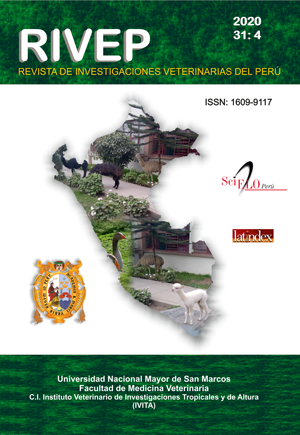Influence of climatic seasons in the presence of canine leptospirosis in northern and central Lima, Peru
DOI:
https://doi.org/10.15381/rivep.v31i4.19018Keywords:
leptospirosis, dogs, weather, seasons, PeruAbstract
The aim of this study was to identify the behaviour of canine leptospirosis and its relationship with climatic seasons in the city of Lima, Peru. A retrospective study was designed analysing the results of canine sera that were evaluated with the micro-agglutination test (MAT) and its association with climatic data obtained from the National Meteorology and Hydrology System of Peru (SENAMHI) between 2014 and 2017. A generalized linear model was used to evaluate the association between positive cases to canine leptospirosis and the seasons, together with the adjustment of risk factors. The probability of presenting canine leptospirosis was higher in the spring-summer seasons compared to the autumn-winter season (p<0.05). Dogs diagnosed as positive were exposed to an air temperature of 20.6 °C and a relative humidity of 83.1%. Age, sex and place of origin showed no statistical association with the positive cases of Leptospira sp. It is concluded that the hottest seasons of the year (spring-summer) in the city of Lima are associated with canine leptospirosis.
Downloads
Downloads
Published
Issue
Section
License
Copyright (c) 2020 Enrique Serrano-Martínez, César Burga Cisterna, Elizabeth Hinostroza M., Renato Zúñiga F.

This work is licensed under a Creative Commons Attribution-NonCommercial-ShareAlike 4.0 International License.
AUTHORS RETAIN THEIR RIGHTS:
a. Authors retain their trade mark rights and patent, and also on any process or procedure described in the article.
b. Authors retain their right to share, copy, distribute, perform and publicly communicate their article (eg, to place their article in an institutional repository or publish it in a book), with an acknowledgment of its initial publication in the Revista de Investigaciones Veterinarias del Perú (RIVEP).
c. Authors retain theirs right to make a subsequent publication of their work, to use the article or any part thereof (eg a compilation of his papers, lecture notes, thesis, or a book), always indicating the source of publication (the originator of the work, journal, volume, number and date).



